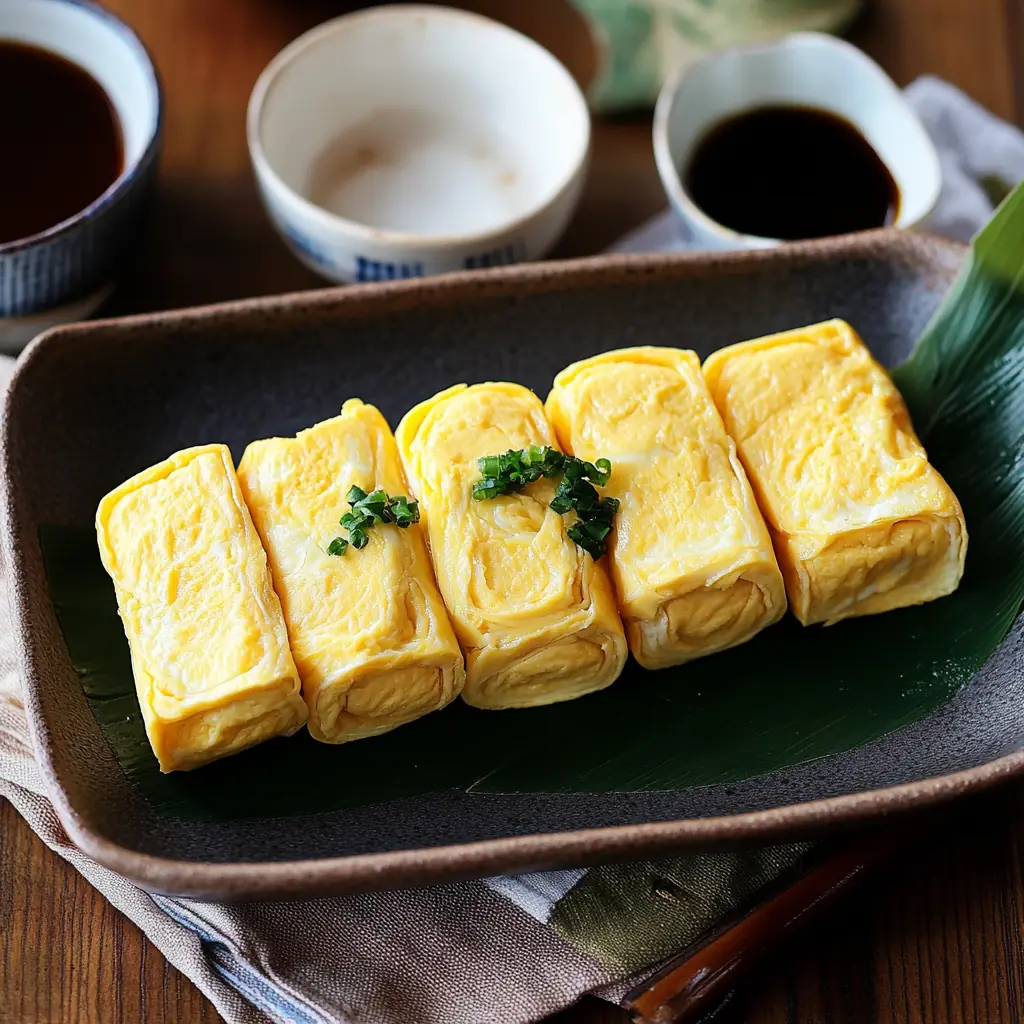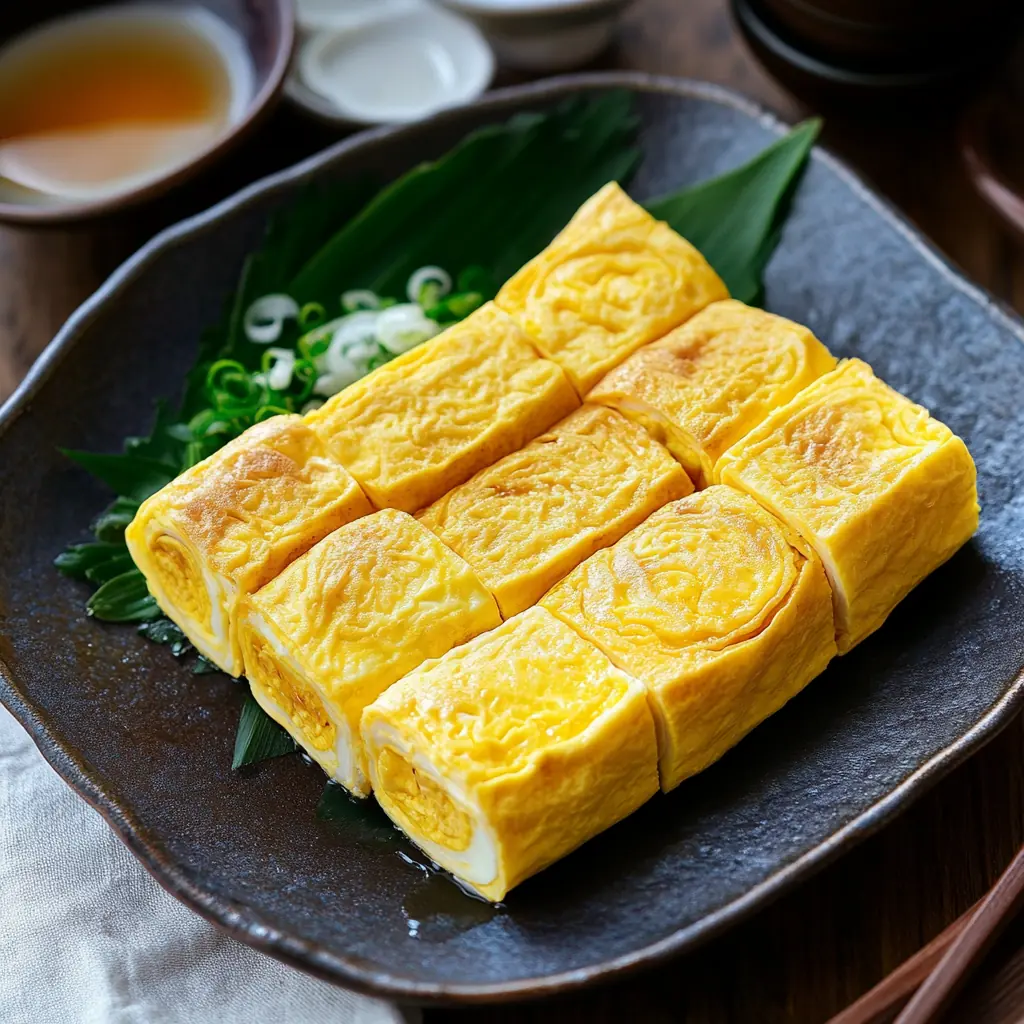When I first tried making tamagoyaki, I was amazed at how such a simple combination of ingredients could create something so elegant and flavorful. I remember watching Japanese chefs roll these golden omelettes with such precision, and I was determined to recreate it in my own kitchen. After a few trials, I developed my 3-Ingredient Simple Tamagoyaki recipe that is not only easy but also perfectly balanced between sweet and savory. This recipe has quickly become one of my go-to dishes for breakfast and bento lunches, especially on busy mornings when I want something quick yet impressive.

Why you’ll love this recipe is simple: it’s incredibly quick, requires only a few ingredients, and produces a fluffy, flavorful omelette every time. Even if you are a beginner in cooking, you’ll find tamagoyaki surprisingly easy to make once you follow the steps. Moreover, the sweet-salty flavor profile is versatile enough to pair with rice, salad, or even a light soup. Personally, I love slicing it into bite-sized pieces and adding it to a colorful bento box—it instantly elevates the meal.
This tamagoyaki recipe is versatile, allowing you to experiment with your preferred seasonings or adjust the sweetness. You can also make it slightly savory by reducing the sugar or adding a small pinch of extra salt. Additionally, I sometimes sprinkle finely chopped herbs or a touch of grated cheese between the layers for a modern twist. Whether you serve it as a side dish, in a sandwich, or in a lunchbox, it never fails to impress family and friends.
Another reason I enjoy this recipe is that it’s budget-friendly. With just eggs, sugar, salt, soy sauce, water, and a little oil, you can create a dish that feels gourmet without spending much. Eggs are inexpensive and widely available, making this tamagoyaki an accessible treat any day of the week. Plus, the ingredients are likely already in your pantry, so you can whip this up spontaneously without a special trip to the store.
Ingredients for 3-Ingredient Simple Tamagoyaki:
-
3 large eggs (50 g each without shell)
-
½ Tbsp sugar (adjust up to 1 Tbsp for a sweeter taste)
-
1 pinch salt
-
1 tsp usukuchi (light-colored) soy sauce or regular soy sauce (use gluten-free if needed)
-
1 Tbsp water (optional for a fluffier texture)
-
1 Tbsp neutral oil (plus more if needed for cooking)
This simple combination of ingredients is all you need to enjoy authentic Japanese rolled omelette right at home, and in the next section, I’ll guide you through the step-by-step cooking process so you can master it effortlessly.
How to Make 3-Ingredient Simple Tamagoyaki
Making tamagoyaki might seem intimidating at first, but once you understand the technique, it becomes surprisingly easy and even enjoyable. I like to think of it as a mindful cooking experience, where patience and timing are just as important as the ingredients. Whether you are using a traditional tamagoyaki pan or a regular frying pan, following the steps carefully will ensure a perfectly rolled, fluffy omelette every time.
Step-by-Step Instructions for Making Tamagoyaki
-
Prepare the Ingredients: First, crack the eggs into a bowl. Add sugar, a pinch of salt, soy sauce, and water if you are using it. Whisk everything together until the mixture is smooth and slightly frothy. This step is crucial because it ensures even cooking and a light texture.
-
Heat the Pan: Place your tamagoyaki pan or a small nonstick frying pan over medium heat. Add about 1 teaspoon of neutral oil and spread it evenly using a paper towel or a brush. The pan should be hot but not smoking; otherwise, the eggs may burn before you have a chance to roll them.
-
Cook the First Layer: Pour a small amount of the egg mixture into the pan, just enough to cover the bottom. Tilt the pan slightly to spread it evenly. Cook until the egg is about 70% set but still soft on top. The key is to avoid overcooking because it will make rolling difficult.
-
Roll the Omelette: Using chopsticks or a spatula, gently roll the egg layer from one end to the other. Push the rolled omelette to one side of the pan. If needed, add a little more oil to prevent sticking.
-
Add More Egg Mixture: Pour another thin layer of the egg mixture into the empty space in the pan. Lift the rolled omelette slightly so the new layer flows underneath it. Cook again until almost set. Then, roll the existing omelette back over the new layer, forming a thicker roll.
-
Repeat the Process: Continue adding thin layers of the egg mixture and rolling until all of it is used. Each layer should be cooked gently to maintain softness. By the end, you will have a neatly layered, golden-brown tamagoyaki that is slightly sweet, savory, and beautifully textured.
-
Shape the Omelette: Once cooked, transfer the tamagoyaki onto a bamboo mat or a clean surface. You can gently shape it into a rectangle using the mat or your hands wrapped in a paper towel. This gives it the traditional look of Japanese rolled omelette.
-
Slice and Serve: Allow the tamagoyaki to rest for a minute or two, then slice it into even pieces. I prefer 1–1.5 cm thick slices for bento boxes, but you can adjust according to your preference. The layers should be visible, showing a delicate swirl effect.
Quick and Easy Tips
For a quicker method, use a nonstick pan and slightly larger egg layers; this reduces rolling time but may produce fewer distinct layers. Ensure your heat is consistent to avoid browning too much. If you are in a hurry, a whisked egg mixture can be poured in slightly larger portions to speed up the process while maintaining softness.
Customizable Options
While this is a 3-ingredient base recipe, you can customize it to suit your taste. Adding finely chopped herbs, spinach, or even a little grated cheese between layers creates a unique version that still cooks quickly. You can also adjust sweetness by adding a bit more sugar or balancing with a touch more soy sauce.
Crowd-Pleasing Appeal
Tamagoyaki is a crowd-pleaser for all ages. Its mild sweetness, combined with savory umami from the soy sauce, makes it appealing for children and adults alike. It works perfectly as a breakfast dish, a side in a Japanese-inspired meal, or an attractive bento box addition. Many of my friends are surprised that such a simple recipe can be so satisfying and visually appealing. With practice, rolling tamagoyaki becomes almost meditative, and the results are always impressive.
By following these steps, you will master the art of the Japanese rolled omelette and gain a reliable, quick, and delicious recipe that can be made anytime. This dish is simple, yet it feels special because of the technique and the layers that create a beautiful presentation.
Frequently Asked Questions (FAQs)
1. Can I make tamagoyaki without a special pan?
Yes! While a rectangular tamagoyaki pan makes rolling easier, you can use a small nonstick frying pan. The shape may be slightly different, but the taste remains the same.
2. How do I prevent the omelette from sticking?
Make sure to lightly oil the pan before each layer. Using medium heat and a nonstick surface helps a lot. You can also use a paper towel to spread oil evenly.
3. Can I make tamagoyaki in advance?
Absolutely. You can prepare it a few hours ahead and store it in the fridge. Slice it just before serving or pack it into bento boxes. It tastes great cold or at room temperature.
4. Can I adjust the sweetness or saltiness?
Yes, you can increase sugar for a sweeter tamagoyaki or slightly add more soy sauce for a savory touch. Adjusting these ingredients lets you match your taste preferences.
5. Can I add other ingredients?
Definitely. Small additions like finely chopped herbs, spinach, or cheese work well. Just ensure the pieces are small to avoid disrupting the rolling process.
6. How do I make it fluffy?
Adding a teaspoon of water while whisking the eggs helps create a softer and fluffier texture. Whisking well to incorporate air also improves fluffiness.

3-Ingredient Simple Tamagoyaki
This 3-Ingredient Simple Tamagoyaki is my favorite quick Japanese rolled omelette. It’s sweet-savory, fluffy, and perfect for breakfast or bento lunches. With minimal ingredients and easy steps, you can create an impressive dish in just 15 minutes.
- Total Time: 15 minutes
- Yield: 2 servings 1x
Ingredients
-
3 large eggs (50 g each without shell)
-
½ Tbsp sugar (adjust up to 1 Tbsp for sweeter taste)
-
1 pinch salt
-
1 tsp usukuchi (light-colored) soy sauce or regular soy sauce (use gluten-free if needed)
-
1 Tbsp water (optional, for fluffier texture)
-
1 Tbsp neutral oil (plus more if needed)
Instructions
-
Crack eggs into a bowl. Add sugar, salt, soy sauce, and water. Whisk until smooth and slightly frothy.
-
Heat a tamagoyaki or small nonstick frying pan over medium heat. Add 1 tsp oil and spread evenly.
-
Pour a thin layer of egg mixture into the pan. Cook until 70% set.
-
Roll the egg gently from one end to the other. Push roll to one side of the pan.
-
Pour another thin layer of egg mixture into the empty space, lifting the roll slightly so the egg flows underneath. Cook until almost set, then roll the existing omelette back.
-
Repeat layering and rolling until all egg mixture is used.
-
Transfer to a bamboo mat or clean surface, gently shaping into a rectangle.
-
Let rest 1–2 minutes, then slice into even pieces.
Notes
-
Adjust sugar for sweeter or milder taste.
-
Optional herbs or cheese can be added between layers.
-
Use medium heat to avoid burning.
-
Store leftovers in the fridge for a few hours; tastes good cold or at room temperature.
- Prep Time: 5 minutes
- Cook Time: 10 minutes

